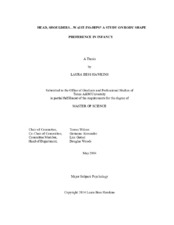| dc.description.abstract | Past adolescent and adult literature has pinpointed clear preferences for male and female body shapes within the context of reproductive fitness and mate selection. However, the question still remains whether individuals are born with preferences for adult-defined attractive body shapes. Alternatively, perhaps particular preferences emerge due to the physical expression of sexually dimorphic body shapes as a result of the pubertal surge in reproductive hormones. The purpose of the present study was to explore the existence of an early preference for adult body shapes. Infants aged 4 to 6 months and 10 to 13 months viewed 8 different computer displays, each containing 2 human figures. In one set (Set A), infants viewed 4 types of displays: 2 male displays, with a small and large waist-to-hip ratio (WHR) figure shown side-by-side; and 2 female displays, with a small and large WHR figure shown side-by-side. In another set (Set B), infants viewed 4 different types of displays: 2 small WHR displays, with a male and female figure shown side-by-side; and 2 large WHR displays, with a male and female figure shown side-by-side. Thus, the paired figures in Set A varied in body shape within stimulus sex. The paired figures in Set B, however, varied in stimulus sex within similar body shapes. Eye-tracking data was collected in the form of durations of looking. Two main findings emerged. First, results from Set A revealed that male infants looked significantly longer to the large female WHR compared to the small female WHR, but looked about equally between the small and large male WHRs. Female infants, however, did not show significant differences in looking to either the female or male pairs. Second, results from Set B revealed that infants looked significantly longer to the female figures compared to the male figures, regardless of body shape. These results suggest that infants, in fact, do not possess preferences for adult-defined attractive body shapes. But, these findings may still signal an early foundation of mate selection strategy related to sex categorization. These explanations and others will be considered. | en |


